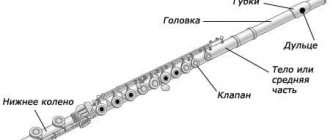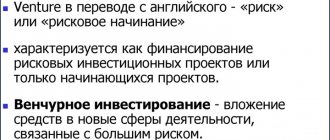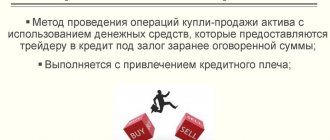olegas Mar 4, 2016 / 167 Views
Terms such as long position and short position often appear in the professional jargon of traders. Or they say that this or that trader is “long” or “short”. Let's clarify what this is and consider opening a long and short position using the example of our hypothetical trader Vasily Alibabaevich Pupkin.
Traders traditionally call a long position the purchase of a financial instrument. Let’s say trader Vasily Pupkin, after analyzing the market, made a forecast that the price of shares should certainly soar upward in the near future. He then buys 1,000 shares at their current price of $1 per share, or, in professional terms, opens a long position in Horns & Hooves & Co. shares. The thrifty and very prudent Vasily spends the sum of $1000. And after some time, when the price of these securities actually rose to the level of $5 per share, Vasya sells them for $5,000, thus closing the long position with a profit of $4,000 (excluding broker commissions, of course).
The concept of a long position on the stock exchange
The mechanics of a long position are easy to understand, which is why it is popular among beginners. So, a trader expects prices to rise and buys shares before they rise in price, and then sells them when the price goes up.
In English, the name sounds like long position, so the term long position (or long) is sometimes used as opposed to short position, or short position (short). The position in question is less risky. The stock market is growing over the long term. Theoretically, a stock can rise in price indefinitely, so short-term price movements do not frighten the trader. If assets fall in price at a particular moment, the price will recover over time, and there will be a profit from the sale.
A long position on Forex is called Buy, although this concept came here from the stock exchange. Long in Forex means that the trader bought the currency at a low price and will wait for it to rise before selling.
Long position is popular among beginners
There are similar transactions in futures trading. The essence is the same everywhere - a trader buys a financial asset (security, cryptocurrency) and opens a position in anticipation of a rise in prices.
The difference lies in the details. When trading futures, a long can have a long period - up to the delivery date of the commodity specified in this contract. Although experts do not recommend keeping it for that long.
On a crypto exchange, the essence of a long position does not change, but margin trading is carried out here more often than on a stock exchange. This term refers to the use of leverage. A trader borrows funds from a brokerage company when he does not have enough money to buy an asset. This is similar to lending. On the first day you can use the resources almost free of charge, but from the next day interest accrues. You will also have to pay a commission if you close on time.
Risks of high-low games
Both of these transactions are considered risky, but the risk for short positions is higher.
When trading long, a trader risks only the funds that he invested in the hope of an increase in the value of assets. Profit is not limited, i.e. a stock can soar tens or even hundreds of times (if we are talking about several years or decades).
The most negative scenario for him is the bankruptcy of the issuer, in which case the trader may lose his investments.
By trading short, the trader risks more.
- First, he borrows money from the broker and pays a daily commission until the position is closed.
- Second, potential profits are limited by the stock price. Conventionally, if a package of certain shares costs 10,000 rubles, then the trader can win a maximum of 10,000 rubles, and only if the company goes bankrupt, which does not happen so often. If the price starts to rise, the trader will suffer losses, and the higher the price rises, the more significant these losses will be.
It turns out that when going long, the profit is not limited, and the probable loss is limited. But with a short, it’s the other way around—profits have a ceiling, but losses have no ceiling.
Rules for making money on long positions
To a beginner, a long position seems simpler, but in practice it is difficult to predict a price increase. The wait may last months or years. In Forex, events develop faster, but a beginner should still follow the rules:
- Do not enter into trades with a large number of profit points. It will take a long time to hold the position; this requires patience and experience. Many beginners are nervous and rush to close a deal, and as a result, they lose money. You need to use a tool such as take profit, it allows you to fix profits.
- Think through your strategy. To predict price increases, you need to use not only technical, but also fundamental analysis.
- Remember that going long on the stock exchange carries risks, but they can be managed. You should definitely use a stop loss to limit losses along with a take profit order.
Diversification of investments is also important. This is especially true for portfolio investing on the stock exchange.
On the importance of basic concepts
In mastering trading wisdom, in fact, like any other, you need to follow the principle from less to more. That is, start with the simplest, I would even say primitive, things, and gradually move on to more complex ones. I say again, it’s clear that basic things may not be the most interesting for a novice trader.
Well, judge for yourself, a newbie comes to the stock exchange and wants to earn huge sums. He is potentially looking for information that will give him answers on how to earn these same amounts. But instead, it suddenly turns out that he needs to start by learning the basic terminology in this area.
In general, I very often remember myself when I first started studying this field. Even when I first decided to join a special forum, I suddenly discovered that people were using terms that were completely incomprehensible to me. For example, CHIF, JAP, KIWI, etc. Over time it became clear. That all this relates to the designation of currency pairs, but at that moment it seemed like, what kind of nonsense are these people talking about?
Topic: Forex Secrets
Roughly speaking, why do we need a base? For example, how to determine a trend in Forex. Yes, first of all, to be on the same wavelength even with other people. One way or another, you will need to get information from somewhere, and for the most part, you will get it from various forums and thematic sites. Ultimately, without knowing the same basic terminology, you will most likely not even always understand what is being said.
Topic: Breakeven
I'm not even talking about the fact that a lot of information can be obvious shit, but in order to understand what this information is trying to convey to you, one way or another, you need to clearly understand the basic concepts. Within any field, the development of a specialist proceeds according to the principle from least to greatest.
How to open a long position
Long positions in the stock market are buying at a minimum price. The discovery can be seen with an example. The trader makes a forecast regarding the growth of the security. The current cost is 75 rubles, he buys 20 pieces for the amount of 1,500 rubles. In September next year the price reaches 126 rubles per share. The trader will then close the trade to make a profit.
How to open a long position
When a long position is opened, this means that the transaction can be executed immediately or pending orders can be placed. A trader can use the tools buy limit (command to purchase an asset) and buy stop (stop when the specified parameters are reached). Both orders are triggered correctly only if the market is in an uptrend.
Short position: what is it?
There are two types of transactions possible in financial markets: buying and selling. In trading platforms, several types of orders are often available for each of them: a transaction can be executed immediately, at the current market price, or later, if certain conditions are met (such an order is called a pending order).
A short position is a transaction to sell a financial asset. It is opened in order to make money by reducing the price. That is, if a trader understands that the price will soon fall, he can now sell the stock at a higher price and later buy it at a lower price. The difference will be profit.
When to close a long position
Trading is associated with risks - they can be minimized, but they are always present. A long position in financial trading is no exception. If the timing is incorrect, the trader will suffer losses. There are rules:
- The transaction is not closed until the market situation contradicts the forecast.
- The position is held if the loss does not reach the forecast value for which the stop loss is set.
- It is held until the income level reaches the take profit value.
The most difficult thing is to understand that the position must be closed because the market situation is changing. Chart analysis, which helps determine the right moment, is facilitated by the TradingView web service. But he only considers technical analysis, and you also need to take into account fundamental data.
Retreat
You see, judge logically what will happen if a simple ordinary person is put at the controls of an airplane. Will he be able to fly it? Naturally, you will think that this is all nonsense, because before you fly, you need to study for a very long time, and at the same time, have not only theoretical knowledge, but also practical skills.
Watch a video review about Forex transactions
Accordingly, why do people suddenly think that you can come to the market, not learn anything, and at the same time start getting fabulously rich? Partly, you can understand where your legs grow from, and they grow from the ubiquitous advertising, which constantly pushes into your head the idea that trading is extremely simple. But at the same time, you can become fabulously rich.
Topic: Uptrend
But here a person must include critical thinking, because promising does not mean getting married. You can say a lot of things, but it is far from certain that all this information will be constructive and useful. Here everything goes according to the principle if you don’t screw it, you won’t survive. Forgive me for such rude bad manners, but you can’t erase the words from the song. Nowadays there are many people, they are often called near-market people. These are people who have not earned a penny through their trading actions. Their main profit is the skillful peddling of their shitty material, which sometimes doesn’t even make sense.
The first thing you must understand is that you need to learn, constantly improve. On the market, even any small detail can cause serious resonance, this is the so-called Butterfly effect. Now, let's get closer to the topic.
Pros and cons of long positions on the stock exchange
A long position on the stock exchange is a more understandable phenomenon for a beginner than a short position; this is its main advantage for trading. From a psychological point of view, such trading is perceived better.
Example of a long position
Advantages:
- A long position means that the trader does not need to constantly monitor market prices, fearing every fluctuation. He opens a trade, hoping that, despite small deviations, prices will rise.
- A long position on the stock exchange is easier risk management because the behavior of quotes is more predictable than in the case of a short position.
- This type of transaction is universal and is used for any financial instruments - securities, options, futures contracts, etc.
A long position also has disadvantages. When prices begin to fall sharply (20% from previous highs) and quotes decline, traders who continue to hold long trades may find themselves in large losses.
Another disadvantage is that in the stock market, such strategies take a lot of time, because of this, traders miss out on other financial opportunities. In foreign exchange markets, events develop faster, but there is also a risk of lost profits.
Long options contracts
In the world of options contracts, "long" has nothing to do with time periods; instead, it is associated with ownership of the underlying asset. A long position holder is an investor who currently holds the underlying asset in their portfolio.
When a trader buys or owns a call option, he is taking a long position because he has the opportunity to buy the asset. An investor who is long a call option buys the call in anticipation of an increase in the value of the underlying security. He is confident that the value of the asset is increasing and can exercise the option to buy it before the expiration date.
But not every trader with a long position believes that the value of the asset will rise. An owner of an underlying asset who believes its value will fall can buy a put option. He will also go long because he has the opportunity to sell the underlying asset that is in his portfolio. The holder of a long position believes that the price will fall and holds it in the hope that at expiration he will be able to sell the underlying asset at a profit.
So, a long position in an options contract can express either bullish or bearish sentiment depending on the type of option.
A short position in an options contract does not involve owning shares or another underlying asset, but rather borrowing with the expectation of selling and then repurchasing at a lower cost.
Examples of trades on long positions
On the stock market it will look like this: in October we buy shares of company A at a price of 63 rubles (100 shares in total) and hope for further growth. After three weeks, quotes rise to 83 rubles and reach the level of the set take profit. The transaction is closed automatically by the sale of these securities. Income is 8300-6300 = 2000 rubles, that is, 20 rubles per share.
Another example can be given in the foreign exchange market. The euro to dollar exchange rate is 1.09. We buy 0.01 standard lot (1000 euros) at this price. Three days later the price increases to $1.12, but technical analysis shows a reversal. We decide to close the deal, sell euros and receive $1,120. The income value is small - $30. In practice, a trader uses leverage and buys a large amount of currency. This allows him to effectively trade not only on his own, but also on borrowed funds, so that the income will be greater.
In this example, with a deposit of $1000, you can use leverage of 1:100 and buy 1 lot. Then the income will increase to $3,000. But taking into account the fact that the transaction was postponed (the closure took place three days later), you will have to pay a percentage to the broker according to his tariffs.
Contents
- What is a short (short position)?
- Short it...? How shorting works in trading
- When is the best time to open short positions?
- In which markets can you open short positions?
- Short Positions: Trading Strategies
- How to short CFDs?
- How to short stocks?
- Why might the ability to open short positions be limited?
- How to open a short position in MetaTrader
- Conclusion
- Continue your Forex education
- About us: Admirals
How to short stocks?
Thanks to new technologies, shorting the market has never been easier. The key is to use the right platform. For example, the MetaTrader Supreme Edition plugin for MetaTrader 5 allows you to trade CFDs on US, EU and UK stocks with advanced platform capabilities.
Source: Admirals MT5 Supreme Edition, #AAPL, Weekly - Data range: October 2, 2022 to January 24, 2022 as of January 24, 2022 Please note: Data presented refers to past performance and is not a reliable indicator of future results.
The chart above shows the movement of Apple stock. The MT5 Supreme Edition platform allows traders to view historical stock price data, as well as the ability to use a range of free indicators to help make trading decisions.
To open a short position, simply click on the “Sell” button. You can also set stop loss and take profit levels. These orders help traders close their positions at predetermined price levels to lock in profits or limit losses.
To check out how easy it is to trade on the MetaTrader Supreme Edition platform, simply click on the banner below to begin your free download! ▼▼▼











